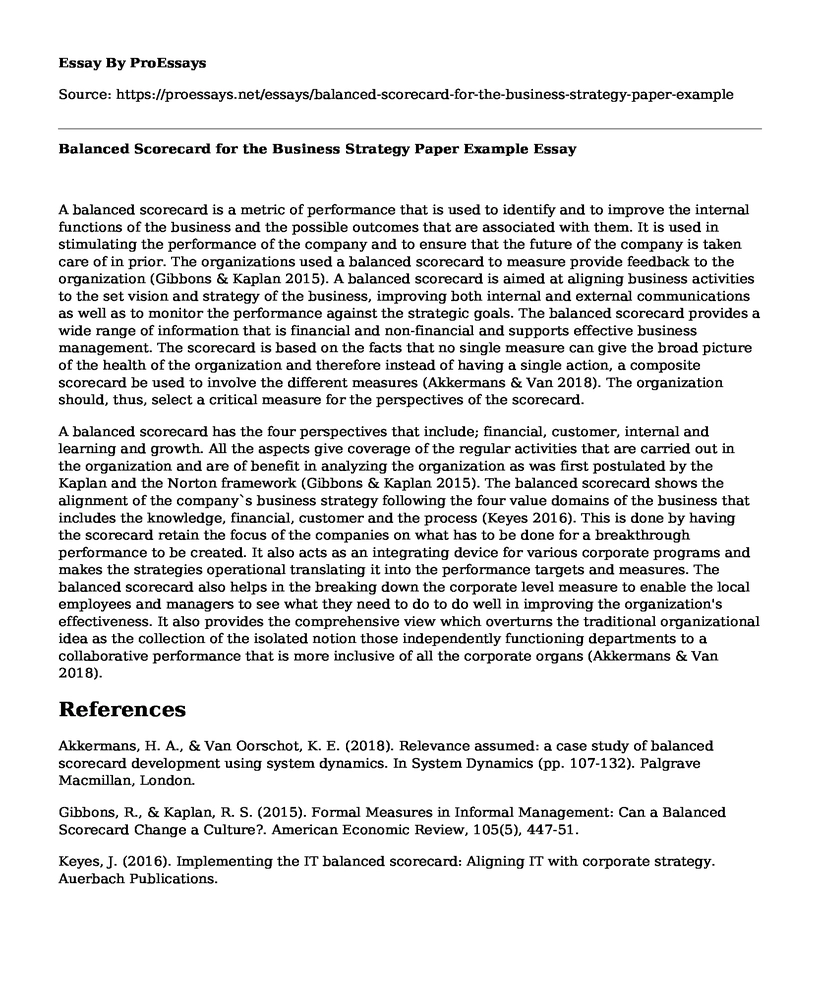A balanced scorecard is a metric of performance that is used to identify and to improve the internal functions of the business and the possible outcomes that are associated with them. It is used in stimulating the performance of the company and to ensure that the future of the company is taken care of in prior. The organizations used a balanced scorecard to measure provide feedback to the organization (Gibbons & Kaplan 2015). A balanced scorecard is aimed at aligning business activities to the set vision and strategy of the business, improving both internal and external communications as well as to monitor the performance against the strategic goals. The balanced scorecard provides a wide range of information that is financial and non-financial and supports effective business management. The scorecard is based on the facts that no single measure can give the broad picture of the health of the organization and therefore instead of having a single action, a composite scorecard be used to involve the different measures (Akkermans & Van 2018). The organization should, thus, select a critical measure for the perspectives of the scorecard.
A balanced scorecard has the four perspectives that include; financial, customer, internal and learning and growth. All the aspects give coverage of the regular activities that are carried out in the organization and are of benefit in analyzing the organization as was first postulated by the Kaplan and the Norton framework (Gibbons & Kaplan 2015). The balanced scorecard shows the alignment of the company`s business strategy following the four value domains of the business that includes the knowledge, financial, customer and the process (Keyes 2016). This is done by having the scorecard retain the focus of the companies on what has to be done for a breakthrough performance to be created. It also acts as an integrating device for various corporate programs and makes the strategies operational translating it into the performance targets and measures. The balanced scorecard also helps in the breaking down the corporate level measure to enable the local employees and managers to see what they need to do to do well in improving the organization's effectiveness. It also provides the comprehensive view which overturns the traditional organizational idea as the collection of the isolated notion those independently functioning departments to a collaborative performance that is more inclusive of all the corporate organs (Akkermans & Van 2018).
References
Akkermans, H. A., & Van Oorschot, K. E. (2018). Relevance assumed: a case study of balanced scorecard development using system dynamics. In System Dynamics (pp. 107-132). Palgrave Macmillan, London.
Gibbons, R., & Kaplan, R. S. (2015). Formal Measures in Informal Management: Can a Balanced Scorecard Change a Culture?. American Economic Review, 105(5), 447-51.
Keyes, J. (2016). Implementing the IT balanced scorecard: Aligning IT with corporate strategy. Auerbach Publications.
Cite this page
Balanced Scorecard for the Business Strategy Paper Example. (2022, Sep 11). Retrieved from https://proessays.net/essays/balanced-scorecard-for-the-business-strategy-paper-example
If you are the original author of this essay and no longer wish to have it published on the ProEssays website, please click below to request its removal:
- DC Shoes: Product Development and Promotion Strategies Paper Example
- Discussion Board Example: Workforce Diversity as a Nursing Trend
- Research Paper on Leadership Approaches
- Project Proposal for Increase the Profits and Augment the Product Portfolio of the Seamus Company
- Essay Sample on Great Leaders: Mahatma Gandhi and Beyond
- Essay Example on Understanding Leadership: Defining Capacity to Stimulate Change
- Paper Example on Bradley Furniture Inc: Threats Amidst Growth & Financial Losses







